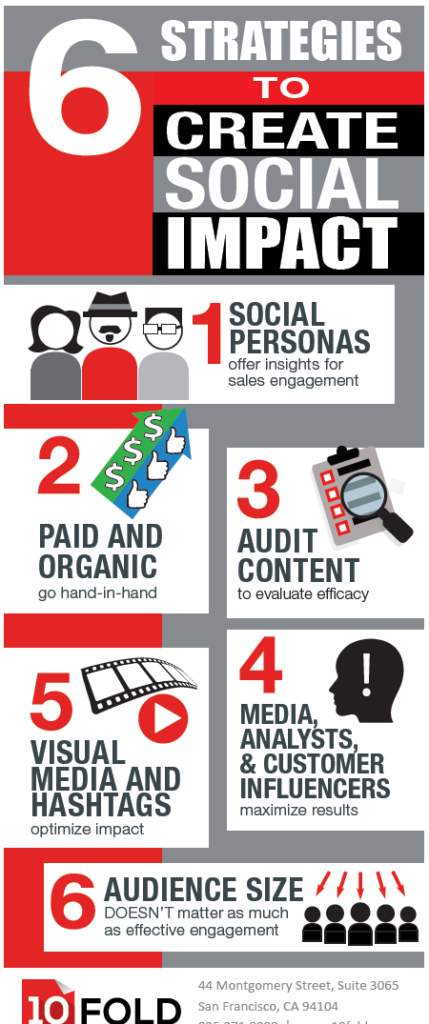For those of you who missed our recent CMO dinner discussing Six Strategies to Create Social Impact, below is the infographic we used – which highlights the points we covered that evening. But since the infographic doesn’t capture all the comments made at the roundtable, we’ll dive into each of the main points in this blog post. As always, if you have questions, feel free to get in touch (info@10fold.com)!

Point 1: Personas historically have been used to better understand and make decisions to attract target customers. The difference is that personas of old are assumptions we made about a group of people, and the way those people are likely to behave. By leveraging the data from social media, we no longer have to guess about some of their preferences and what they do. 10Fold leverages the data available from tools such as Brandwatch (and the Brandwatch audience app) and FollowerWonk to know which topics target customers follow, comment on, like and share. We can also understand the mediums they prefer (video, infographics, case studies, etc.) through those tools. With a little “elbow grease” we can understand which LinkedIn groups they belong to, and which ones they actually participate in. Pro tip: social personas provide information that is both recent and relevant for the purpose of creating content calendars, planning marketing assets, and developing online advertising plans.
RELATED EVENT: Social Media Marketing CMO Happy Hour September 17th
Point 2: It is true that social spend should be based on company priorities. That’s strategic – but only if the content has been first tested organically. Too often, we find content gets the paid treatment before it is clear it will garner real attention from relevant audiences. When content is paid for first, we often find the relevance and lift we get from the paid is not as meaningful. Pro tip: start with organic content on social, and put dollars behind posts that map to company priorities AND are taking off organically.
Point 3: Periodically it is important to measure the efficacy of your content (we recommend quarterly). This entails looking at how certain types of assets (video, infographics, case studies, etc.) are performing with your social audiences. For example, not all videos are popular – especially the longer-form videos (e.g. more than 60 seconds). We also recommend measuring the topics that are performing well. Brandwatch (and other tools) will tell you the content topics that are resonating with your followers (based on likes, shares, and comments). And as a bonus, those same tools can tell you what’s trending on Twitter.
Point 4: Over the last 10 years a new role has evolved: the social influencer. We would argue that the “mommy blogger” may have popularized this concept, as these bloggers would build huge audiences, and companies would send thousands of dollars in free merchandise for review (never to be returned). Now we know that sometimes these social influencers are prominent (respected) customers that come from big brands – and sometimes they are former or current vendors offering similar solutions. Today, many influencers have made a career out of talking about other solutions in the industry, giving opinions, and stumping at conferences for companies making announcements. A few years ago, the going rate for an influencer was a couple of thousand dollars for a half day of posting about a company at a tradeshow. Now some influencers can receive $20K per conference (or more)! The obvious influencers, such as industry analysts and members of the media, have not always required additional payment (although this is changing quickly). However, the most credible influencers for your group may be your own customers. We recommend encouraging customers that are socially active to talk about their successes, and we also recommend that you recognize them on Twitter and LinkedIn for their success – ensuring you mention their handles when doing so.
Point 5: Plain and simple, posts perform better when they have visual aids (such as pictures, gifs, short videos, and/or infographics) or if they use hashtags. We’d like to point out that selecting the most popular hashtags is not always a great idea – it’s like jumping in the deep end of the pool, and how good of a swimmer and how prepared are you? Going after hashtags takes tenacity, and requires you to post in volume to make a dent – as you can easily get lost amid the noise. Unless you have a large team of people, already have a substantial share of voice with that hashtag, or have unlimited funds, we recommend going after more niche hashtags that are highly relevant to you and the content you are posting.
Point 6: For the longest time, companies measured their social efficacy by a number – that is the number of people that followed them on a social channel. We think it’s a percentage, not just a number. Not surprisingly, the best percentage is 100 – that is, 100 percent of the target market that is not only following you on social channels, but that is commenting, sharing and liking your content. If you have 100,000 bots following you that aren’t helping you with social lift, those gaudy numbers add zero value. FollowerWonk measures social authority (the amount of people that interact with your posts) and Brandwatch Audiences measures Influence Score (the makeup of your audience – and their relative importance in your industry). We believe those factors more accurately measure your social initiatives and give you a better sense of how you are doing versus your competitors. Knowing that the people who are following you have status among peers – and are actively influencing others – is the key to success in social.
Our guests were all pleased with our CMO dinner which included delicious food and much wine and laughter – as well as social media insights! We’re sorry to have missed you this time, but we’ll keep you on the list!
[email-subscribers-form id=”1″]